“The Wrong Man” is a docudrama film directed by Alfred Hitchcock, starring Henry Fonda, Vera Miles and Harold J. Stone. The film is based on the true story of a Queens resident, Christopher Emmanuel Balestrero, a professional musician who was wrongfully charged with a series of local robberies. Shot in and around New York City, “The Wrong Man” is notable for being a rare instance of Hitchcock shooting a film almost entirely on location.
The Stork Club & Subway
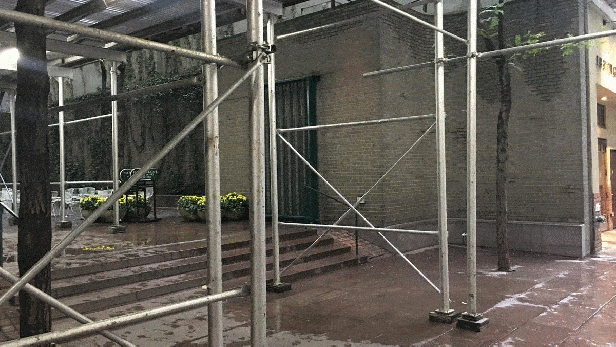
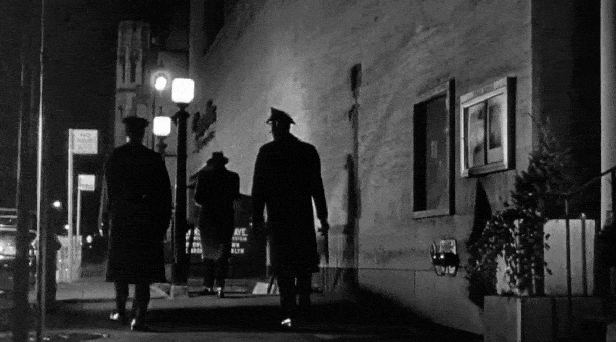
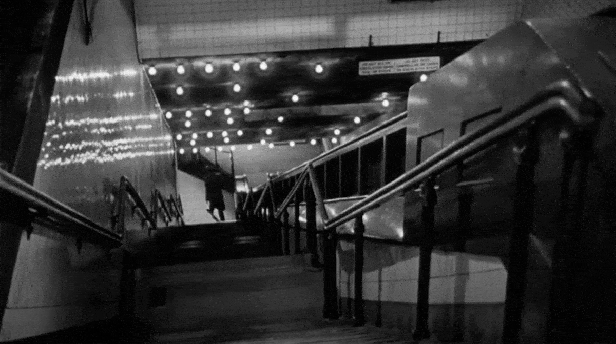
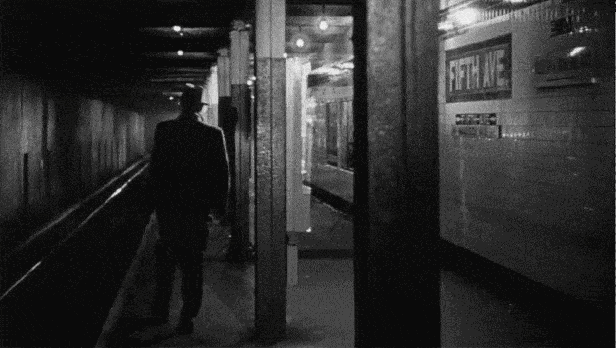
The first scene in the film was an easy one to identify, since it’s clearly stated that Henry Fonda’s character is a bassist at the Stork Club in New York. The subway was easy to identify as well, as he uses the IND station entrance located on the same block.
One noteworthy thing about this sequence is the fact that they filmed inside the actual club, as opposed to a set. It was somewhat rare for a production in the 1950s to shoot inside an actual New York City nightclub, but it was particularly unusual for director Alfred Hitchcock. It was well-known that Hitch felt most comfortable when he was shooting on a studio set where he could have the most control, but The Wrong Man was a definite departure from his usual style and approach. It was the first time he directed a film based on a true story, and he was trying to create as realistic of a film as possible. He told his cinematographer, Robert Burks, “I want it to look like it had been photographed in New York in a style unmistakably documentary.”
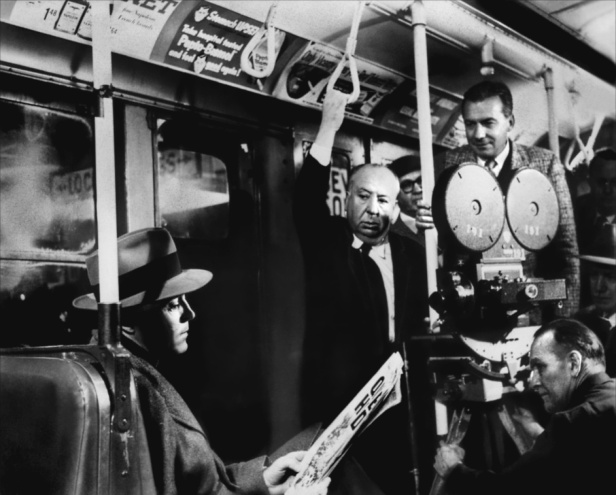
Using a 1953 Life Magazine article about Manny Balestrero’s ordeal as the main source material, Hitchcock tried to enhance the stark realism by filming at the actual locations where the true story occurred whenever possible. And since Manny was a professional musician at the Stork Club, that’s exactly where they shot the opening scene — giving audiences a rare look inside one of New York’s most famous nightspots.
During its existence from 1929 to 1965, the Stork Club was considered one of the most prestigious and swankiest clubs in the world. A symbol of “café society,” the club was home to the rich and famous, and owner Sherman Billingsley had a keen ability to keep the rooms filled to capacity.
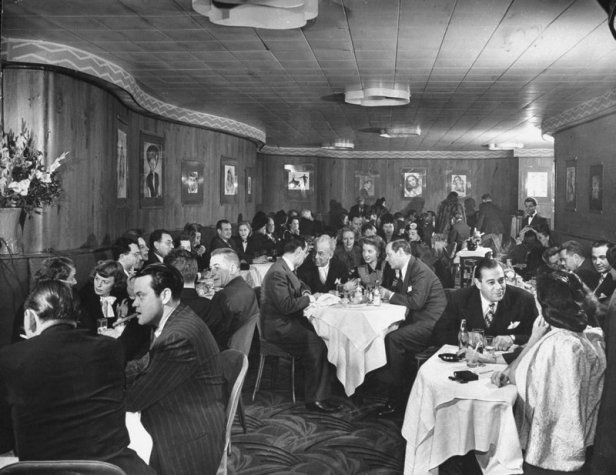
In the spring of 1956, when The Wrong Man was being filmed, the club had already moved from its original West 58th Street location to East 53rd (after a short stint on East 51st) and had become world-renowned for its celebrity clientele. Partly due to Billingsley’s tendency to offer up lavish gifts, there was always a steady stream of celebrities coming in like Lucille Ball, Ernest Hemingway, Frank Sinatra, Grace Kelly or Orson Wells, as well as famous couples like Humphrey Bogart and Lauren Bacall, or Marilyn Monroe and Joe DiMaggio — even the Duke and Duchess of Windsor made multiple appearances at the midtown hotspot (perhaps to grab a bite of the broiled chopped sirloin steak (with French fried potatoes)).

Right around the same time The Wrong Man was being filmed, troubles were brewing for Billingsley and his Stork Club. Newspaper stories of his alleged racist and anti-Semitic behavior started to arise in the 1950’s, and during a highly-publicized strike by the club’s staff, Billingsley retaliated by water-bombing the strikers and picketers outside the club, which didn’t go over well in the eyes of the public. Ultimately, he lost a majority of his staff, friends, and customers and his reputation of a man of class got forever tainted. On October 4, 1965 the famous Stork Club shut its doors forever, and only a couple years later, the building was torn down and replaced with a tiny mid-block park that is there today.
The Balestreros’ Home
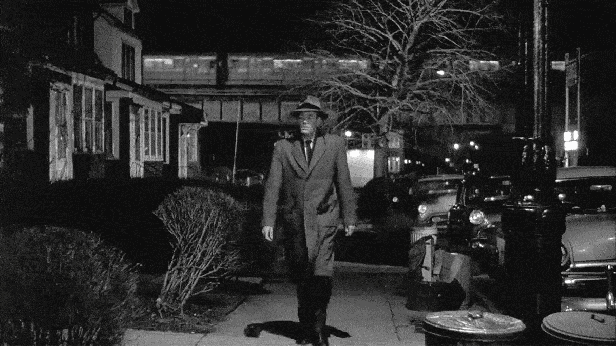
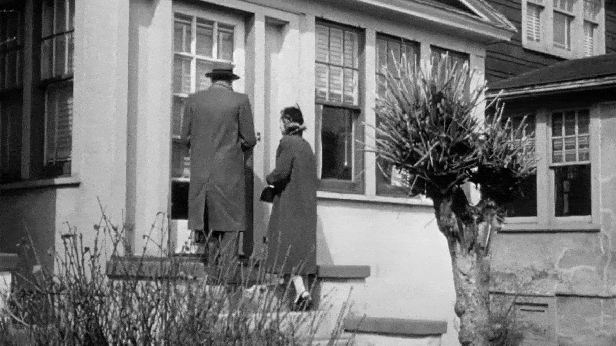
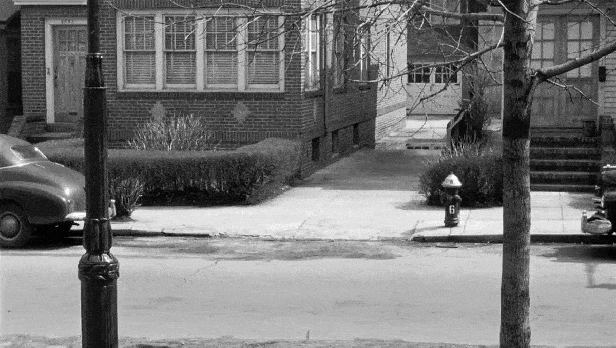
This is one of those happy instances where a character in a movie gives an address and it ends up being the actual location to which they filmed. On a couple instances, Henry Fonda’s character gives his home address as 40-24 78th Street in Jackson Heights, which is exactly where they shot these scenes.
While taking photos of the house for this project in the fall of 2017, I encountered the current home owner as she was on her way out. I asked her if she knew Hitchcock shot a film at her home and she said she did, but didn’t know many details. After showing her some stills from the film, we got to talking a bit, and she graciously permitted me to take a quick peek inside her home. When I stuck my head inside, I noticed that it looked a bit different from the film, and later on I found out why. According to the film’s art director, Paul Sylbert, they actually recreated the Balestrero home back in Hollywood, including the front entrance, whose walls could slide away on the fly to make room for the camera.
All the wide shots of the home’s exterior were filmed on-location in Queens, which is especially obvious when you see the elevated 7-train rumble by in the background. In fact, I imagine it was the close proximity to the visually-interesting El train that made the production decide to film at this house on 78th Street, opposed to the actual Balestrero house at 41-30 73rd Street (whose street block was renamed “Manny ‘The Wrong Man’ Balestrero Way” in 2014).
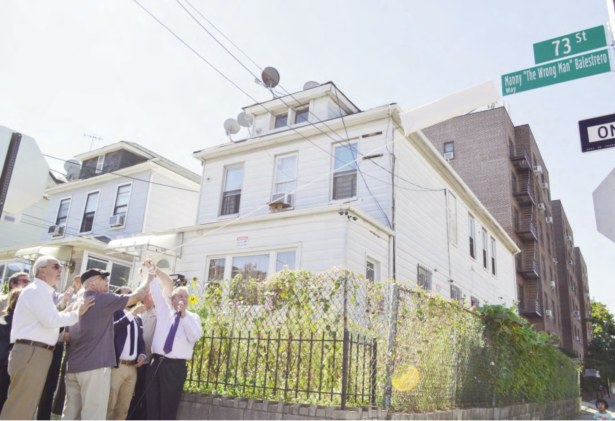
It’s a shame they didn’t shoot the interiors on-location as well, but having seen the inside of the home and how narrow it was, it probably would have been nearly impossible to squeeze all that 1950’s film equipment inside such a cramped space.
(It might be noted that the TCM website claims that Hitchcock supposedly used “Balestrero’s 74th Street home” as a filming location, which as far as I can tell is incorrect but has since been repeated on several other blogs and websites. Curiously, 74th Street doesn’t match the real-life location nor the filming location.)
Going to the Insurance Company
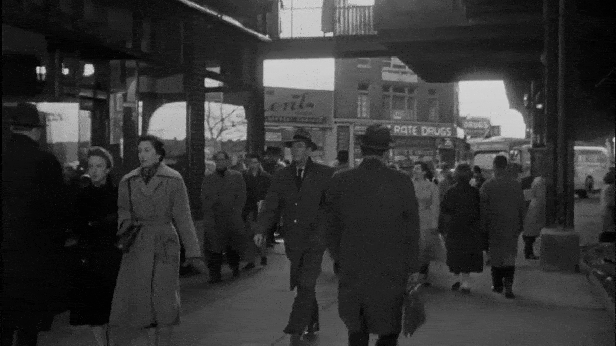
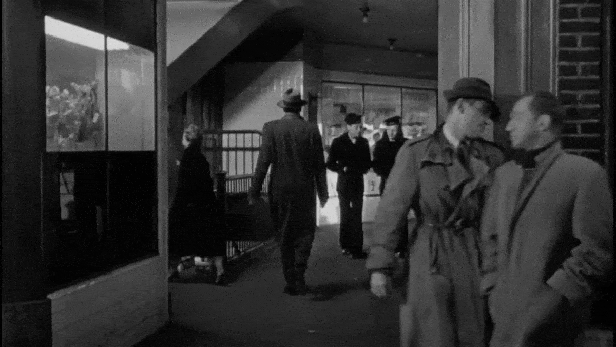
Finding the location of the large subway complex Fonda goes into was fairly simple. Like with the Balestreros’ home, several characters mention the location of insurance company office, namely that it was in the Victor Moore Arcade, which was at the intersection of Broadway and Roosevelt Avenue.
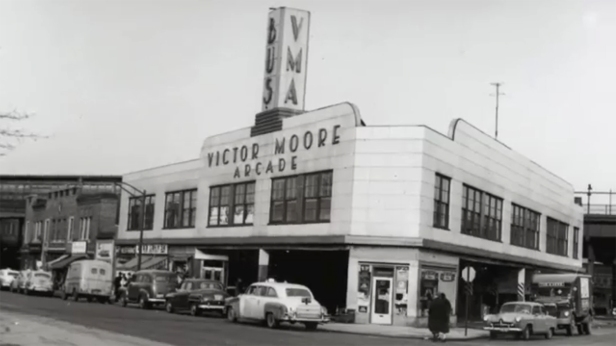
Torn down and replaced in 2005, the original Victor Moore Arcade was named after the actor and comedian who was a long-time resident of Jackson Heights. According to an article in The Queens Courier, Moore won a large sum of money from a horserace in the early 1930’s and wanted to use the funds to help build a bus terminal and business arcade in his neighborhood.  After the Board of Estimate approved his donation, the large depot and retail center was built in 1933 at the Roosevelt Avenue/74th Street subway station where several train and bus lines intersected.
After the Board of Estimate approved his donation, the large depot and retail center was built in 1933 at the Roosevelt Avenue/74th Street subway station where several train and bus lines intersected.
By the mid-1990’s, this Queen’s transportation center was named one of the dirtiest subway stations by a Straphangers Campaign, and plans were soon made to renovate it. A few years later, the city’s project was finally set into motion (which involved kicking out all the local merchants inside the arcade, some of whom still had ten-year leases on their retail spaces).
Completed in the summer of 2005, the current building, renamed “The Victor A. Moore Bus Terminal,” is entirely new and doesn’t retain anything that appeared in this film. And quite frankly, it’s rather boring compared to what used to occupy the site.
Even though I knew they used the Victor Moore Arcade for this scene, figuring out the exact entrance Henry Fonda used took a little work since there’s a completely new subway station there today. Surprisingly, there weren’t a whole lot of vintage photos of the former arcade available on the web. In fact, the best resource I found was a 1994 video on Youtube, showing several nooks and crannies of the subway complex. (You can also watch the video below for a 30-second highlight reel I created.)
In order to figure out the entrance used in this scene, I went to the location in person, and was able to find a few buildings that were around in 1956, including one at 73-16 Roosevelt Avenue, which appeared in the film. Using that building as a guidepost, I figured the entrance Manny walked through was on the south side of Roosevelt Ave, just east of Broadway.
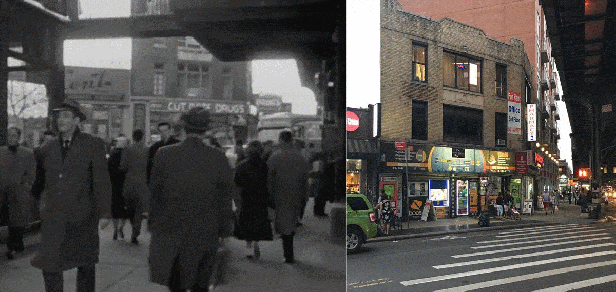
In addition to this entrance, I was also curious to see if I could locate the small cafeteria that Manny goes to at the beginning of the film to eat toast and pick horses in the newspaper. The one clue I had to on was the North Shore Realty office seen across the street through the large window.
After searching the surrounding area, I couldn’t find a building that matched the one seen in the film, but discovered an empty lot at the southwest corner of 74th Street and Broadway that looked promising. When I checked out the address in a 2012 Street View in Google, I could see there used to be a one-story building on that empty lot which resembled the real estate office seen in the film.
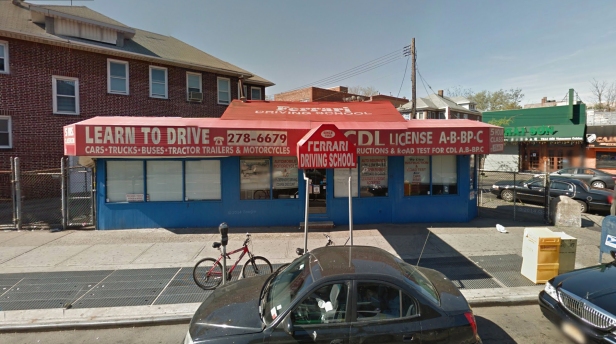
I then searched for a “North Shore Realty” on Broadway on the web, and found a couple want ads in a local paper, one of which was a job opening for a salesman. Fortunately, the ad listed its address as 74-02 Broadway, which would have placed it on that empty lot on the corner of 74th and Broadway. Therefore, the cafeteria Fonda sat in would have been across the street on the Broadway side of the Victor Moore Arcade. I later found out the name of the cafeteria was Bickford’s.
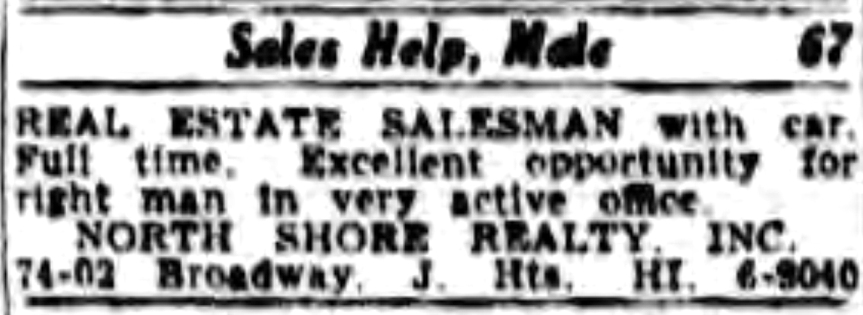
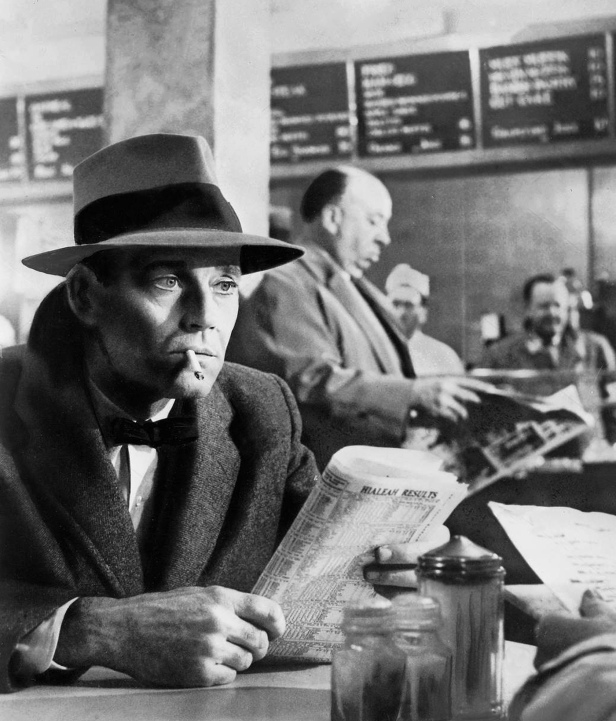
It might be noted that Hitchcock’s traditional movie cameo was supposed to take place during this scene in the cafeteria, but he later decided that it would be too distracting and take away from the realism he was trying to achieve. So instead, he appeared in silhouette in the film’s prologue, explaining how the narrative is based on real events.
Police Station
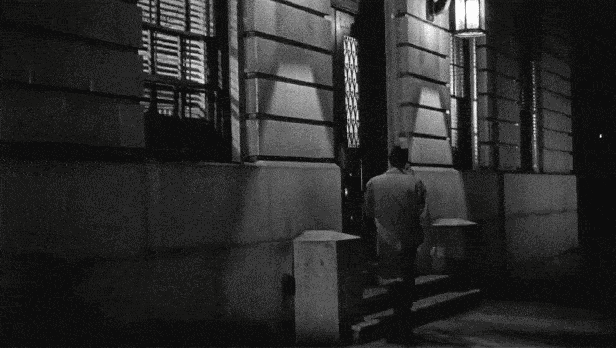
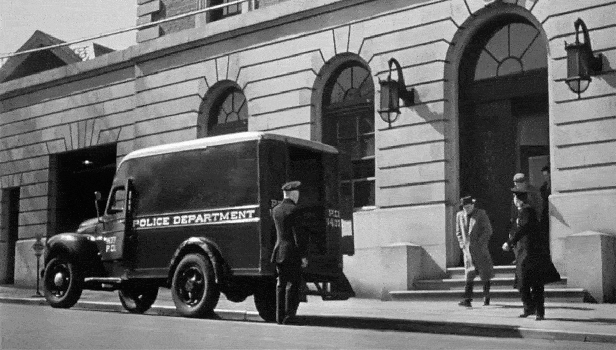
I found this location through an article about “The Wrong Man” on the TCM website. In the article, it mentions that “the 110th and Roosevelt Avenue police stations….were used as location sites in the film.” A quick internet search found the address of the 110th precinct station house to be 94-41 43rd Avenue, and after studying the station and the surrounding buildings, I found enough matching elements to confirm it was the same police station.
However, like with the Balestrero’s home, the interiors of the police station were a set built back in Hollywood.
Visiting the Liquor Store
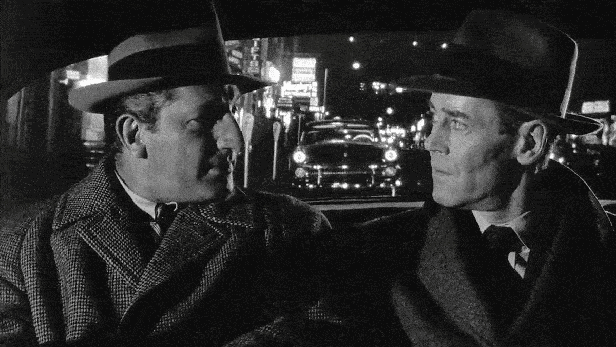
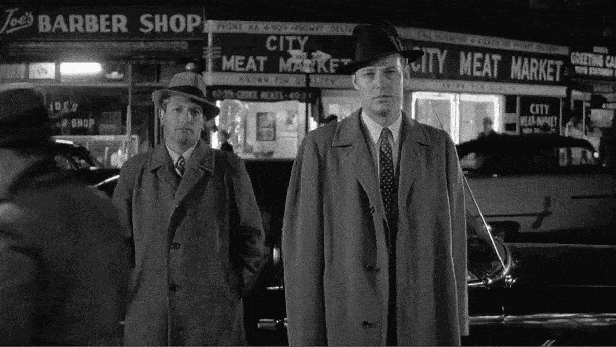
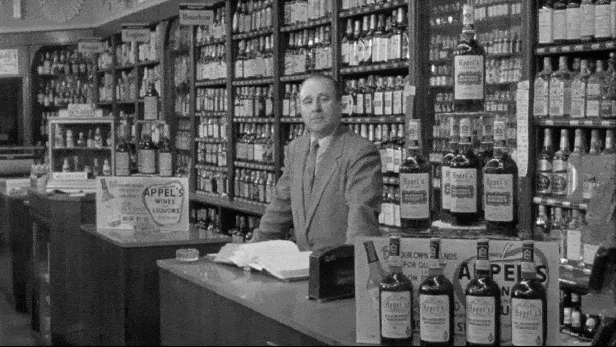
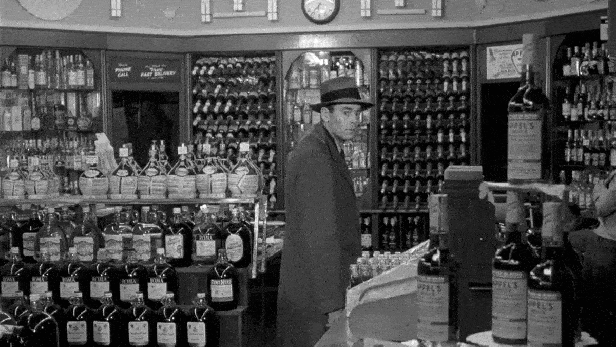
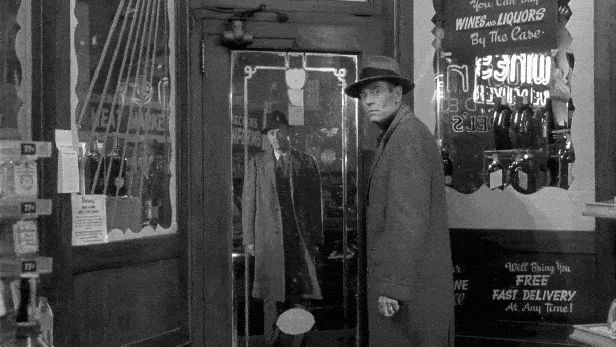
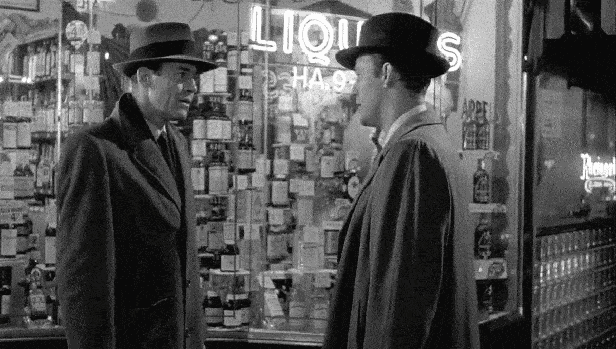
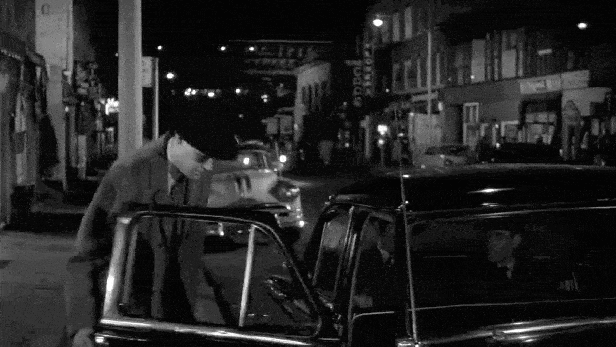
To find this location, I started by doing a general internet search, using such keywords as “liquor store,” “The Wrong Man,” “filming location,” “Queens” in various combinations, but I came up with nothing.
My next strategy was to focus on the oddly-shaped meat market seen across the street from the liquor store. Even though it had a somewhat generic “city meat market” sign above the entrance, it did have a clear address of 40-39. I didn’t know what street they were on, but I thought that if I looked up meat markets/butcher shops in the 1956 Queens yellow pages, I’d hopefully find one with a 40-39 address.
After scanning through the phone directory at the 42nd Street Public Library, I found a listing with an address of 40-39 82nd Street, which seemed very promising. And when I looked up that address on Google Street View, the building there looked very much like the one from the film. The first thing I noticed was that the one-story retail building had the same odd-shape as the meat market. (This is because it was on the corner of Ithaca Street, which cut across 82nd Street at an obtuse 135-degree angle.) I also noticed that the unique pattern of windows on the nearby building at 40-5 Ithaca Street matched the ones seen in the film on the building behind the meat market.
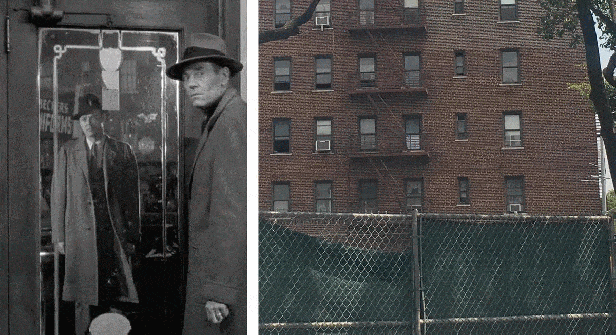
Having confirmed the meat market location, the next step was to figure out the exact address of the liquor store. I knew it was located across the street, but couldn’t tell which of the current stores was the one from the film. I did, however, have a couple of clues to go on. In the scene, you can see a neon sign in the store window showing part of a phone number. Plus, I now knew it was definitely on 82nd Street.
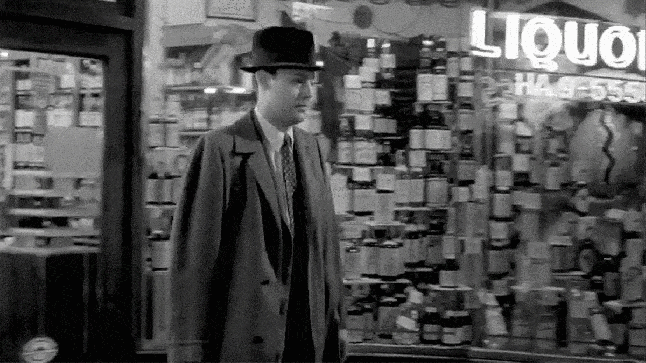
Armed with these two new pieces of information, I was able to use them to execute a more specific internet search, using the keywords, “liquor store,” “Jackson Heights,” and “82nd St.” From that, I was able to find a newspaper ad for Appel’s Wine and Liquor Store located at 40-36 82nd Street which ended up having the same phone number that appeared in the film.
A few months after establishing the exact address, I went to Jackson Heights to take pictures for this project. Unfortunately, by that time, the meat market building was being prepared for demolition. It hadn’t been razed yet, but it was completely surrounded by plank boards and scaffolding. The only good thing was that I could still make out the unique obtuse angle along Ithaca Street, which matched the building in the film.
The liquor store building was still standing, but it had been changed so much —both inside and out— that I couldn’t find any matching details. That being said, it was still cool to stand inside that retail space (which has since become a cafeteria) because I knew that Hitchcock not only used the exterior of the store, but to maintain that sense of realism, used the interior as well.
On the subject of realism, to help create that “documentary” feel, Hitchcock not only used the real-life locations whenever possible, he actually hired some of the people who were involved in Balestrero’s case to portray themselves in the film. According to a 1957 article in American Cinematographer, this included “the husband-wife owners of a liquor store, a policeman, New York City detectives, and the owners of an up-state summer resort.” However, I’m not sure what liquor store owners the article is referring to, as there is only one shopkeeper who appears in this scene, and it was played by John C. Becher, a professional actor with a long list of film/TV credits.
Visiting the Delicatessen
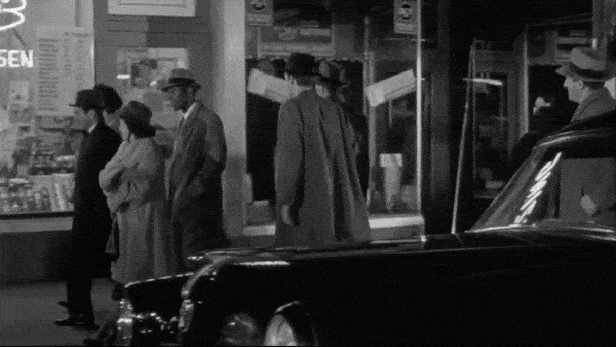
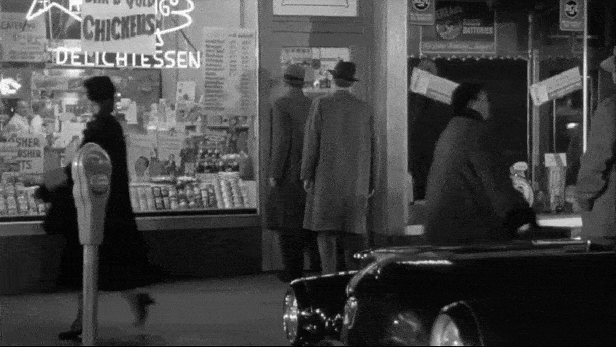
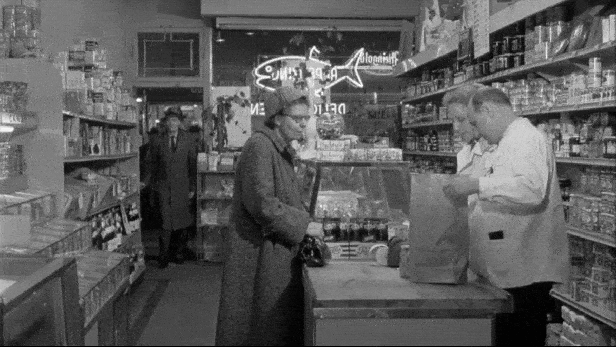
It was while researching this scene that I first discovered a nice movie location website called The Movie District which contained a section for The Wrong Man. The site covers all types of movies that have taken place all over the world, but I found that it had several NYC-based films which hadn’t been very thoroughly covered in other websites. In its Wrong Man entry, the location of the delicatessen Manny visits was listed as 84-20 37th Avenue, which seemed to match up when I checked it out myself.
After discovering The Movie District, I used it as a resource on a few other films (which I will note as they come up), and occasionally, I submitted my own location findings to the website, which included the “Liquor Store” scene from the above.
Crossing the Bridge into Manhattan
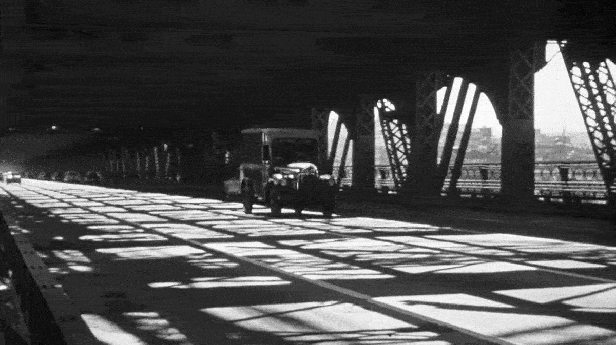
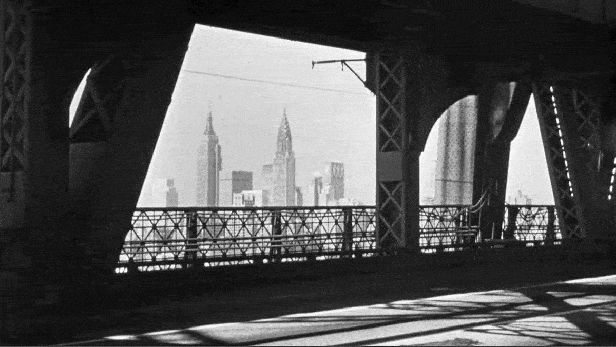
This was a fairly obvious location, as the Queensboro Bridge is more or less the only bridge that would offer the same vantage point of the Manhattan skyline that apeared in the film. And what’s nice is that this location makes geographical sense in terms of the film’s story. That is, if you were coming from Jackson Heights, Queens, the most obvious way into Manhattan would be via the Queensboro Bridge into midtown.
The one tricky part was finding the exact strip of roadway the paddy wagon traveled along. They were obviously on the lower level of the bridge, and judging by the orientation of the Manhattan skyline, I was pretty sure they were closer to the western end of the bridge. When went to the pedestrian path (located on the northside of the bridge), I noticed that the series of beams and girders formed a pattern that repeated itself a few times along the span of the bridge. Fortunately, the specific combination of structural elements that I was looking for only occurred a couple times, and there was only one instance where it occurred at a spot that would offer the same view of the Manhattan skyline that appeared in the film.
I’m pretty sure I got the exact spot from the film when the camera was pointing southwest towards Manhattan (2nd picture above), but to be honest, I was less meticulous when figuring out the exact spot from the film when the camera is pointing east. You can see in the first picture above that the bridge’s superstructure doesn’t line up perfectly. (Hopefully, I’ll return to the bridge at some point and get a more accurate photo.)
Police Headquarters
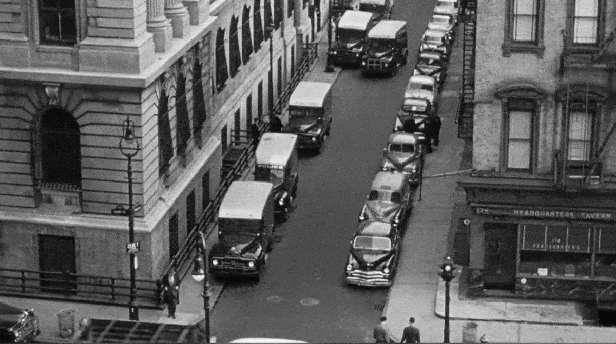
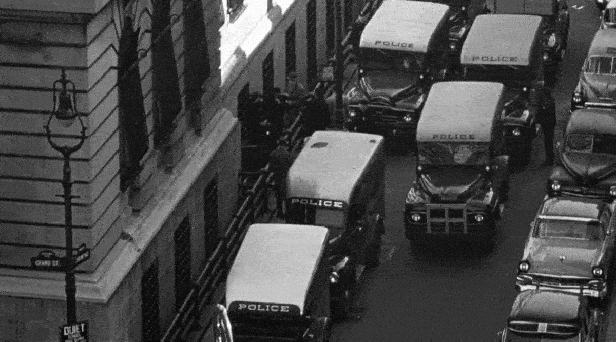
Identifying this location was simple enough, as I was already familiar with the former police headquarters and knew what it looked like. Plus, there’s a street sign for Grand St. visible in the wider shot, just in case there was any doubt where this scene took place.
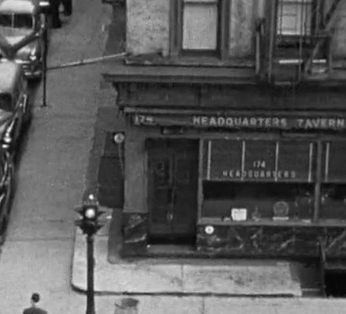 The good thing about this location is that a large municipal building like the former police headquarters rarely gets demolished, so you know it’ll probably be around for years to come. However, it was a nice little bonus to discover that the building at 174 Grand Street, which was the former home of the Headquarters Tavern, is still around and fairly unchanged.
The good thing about this location is that a large municipal building like the former police headquarters rarely gets demolished, so you know it’ll probably be around for years to come. However, it was a nice little bonus to discover that the building at 174 Grand Street, which was the former home of the Headquarters Tavern, is still around and fairly unchanged.
Clearly catering to the law enforcement clientele, the Headquarters Tavern and the actual police headquarters across the street were purportedly linked by a secret underground tunnel, allowing the intoxicated officers a more discrete form of passage. Most likely apocryphal, this story of a secret tunnel for the “Boys in Blue” has become part of the city’s popular lore.
It’s even included on the website for Onieals Restaurant (the current occupants of the space at 174 Grand):
Onieals is located directly opposite the old Police Headquarters that held legendary criminals from 1909 – 1973. The Onieals building operated as a center for pleasurable crimes in such close proximity. Its former occupants include a brothel, a speakeasy, and a gambling parlor. In the early part of the 20th century, the system was so corrupt that a tunnel was built underground to connect the two buildings so that uniformed NYPD officers and officials could step across the street for some cheer undetected.
The tunnel, which ended up coming in very handy during Prohibition, is still visible in Onieals and is used today as the wine cellar. In 1987, the headquarters was sold, turned into luxury residential condos and the tunnel was filled. These luxury condos, commissioned as an NYC landmark, housed some well-known names including Steffi Graf, Winona Ryder and Christi Turlington.
The only frustrating thing about creating the “before/after” pictures for this scene was that it was filmed from an extremely high angle (probably from a nearby rooftop) and I wasn’t able to duplicate the shot with my camera. I actually climbed up some scaffolding on a building across the street in hopes of taking a photo with a similar high-angle as the film — much to the dismay of passing tourists, except for one lady who inexplicably decided to ask me directions to Canal Street as I sat perched on a beam eight feet above her. Unfortunately, the scaffolding didn’t really help at all in trying to match the angle from the film. I did do a little manipulation to my pictures in Photoshop to try to get the angles to line up, but I kind of regret I did that. The pictures ended up looking a little skewed and unnatural. Maybe one day I’ll rent a drone so I can get all the high angle shots from all the films I’ve included in this project.
Going to Court
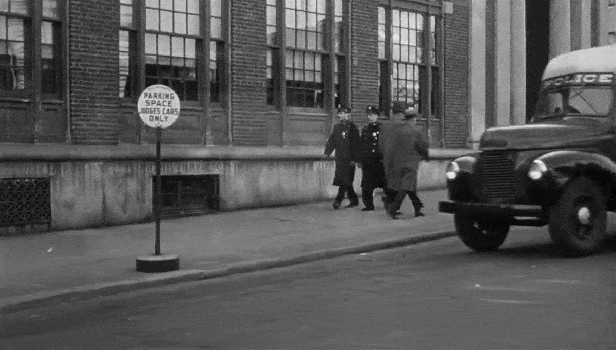
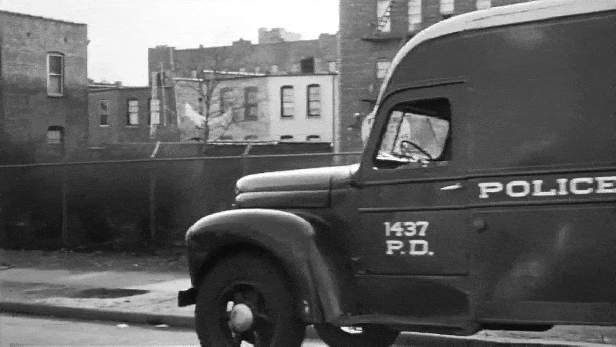
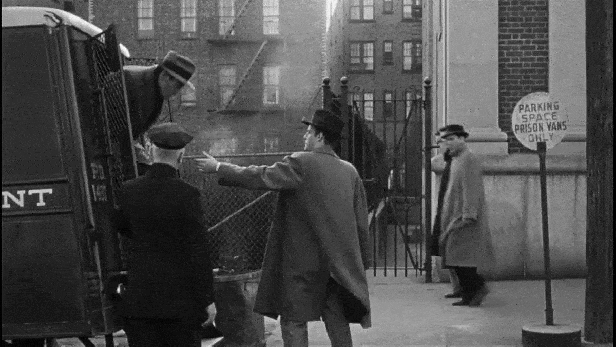
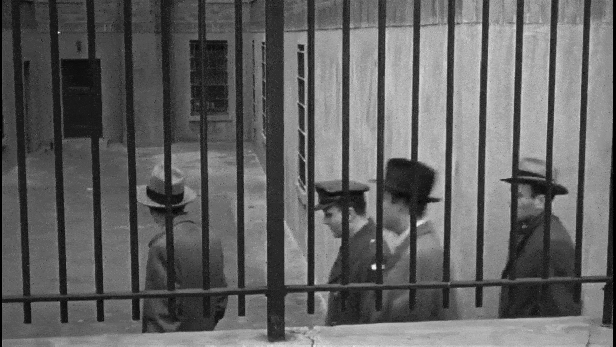
The thing about this movie, since it was based on a true New York story and the fact that Hitchcock used a lot of the actual locations from that story, there was a good deal of contemporaneous articles that actually mentioned the filming locations by name. These articles would, in particular, list a lot of the municipal buildings and institutions used in the film, but unfortunately didn’t mention the courthouse from this scene. It wasn’t until I stumbled upon an article about Ridgewood, Queens on the Forgotten-NY website that I found a reference to this courthouse. It wasn’t in the article itself, but in one of the comments, written by a Michael Olikus:
I lived on Fresh Pond Road, on the corner of Catalpa Ave. from 1947–1962, across the street from public school 88. I lived in a 6-room railroad flat, cold water and a “dumb Waiter.” I spent many a day playing in the old trolley barns, on Fresh Pond Road. The # 13 bus stopped right in front of my house. The 104 Police Station was around the corner on Catapla Ave, as was the court house where “The Wrong Man” starring Henry Fonda was filmed.
I was amazed that the only online reference I could find on this courthouse was from a random comment from a former Queens resident. It was kind of a throw-away tidbit, but fortunately the information turned out to be completely correct. The 104 police station is still around, but the courthouse building is now a YMCA. And the courtyard where the prisoners were seen being led through in the film is now completely enclosed and part of the building’s basement.
Released From Prison
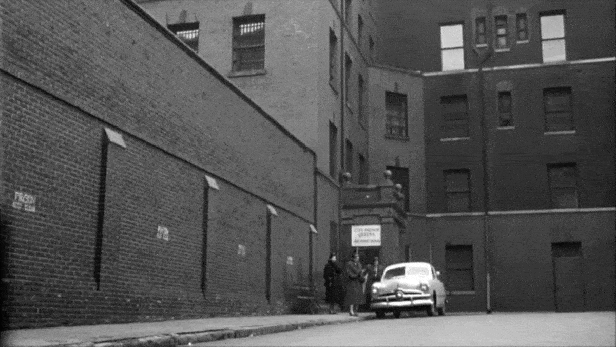
Again, since The Wrong Man was a film directed by the acclaimed director Alfred Hitchcock, there was a lot more information about it on the web (compared to other films from the 1950s), and it was this wealth of information that made figuring out some of these locations a bit easier. The thing that helped me find this scene’s location was a ubiquitous promotional photo of Henry Fonda and Vera Miles outside the city prison.
In the photograph, there’s a giant sign behind the actors with the name of the prison and its street address. When I looked up the address in Google Maps, I found that the building was still around and looked more or less the same.
I imagine if this were a lesser known film from the 1950’s, it probably wouldn’t had been as easy to find so many promotional images and behind-the-scenes photographs on the web.
Visiting the Vacation House

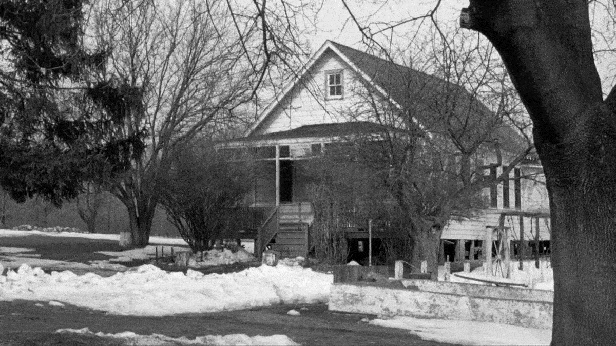
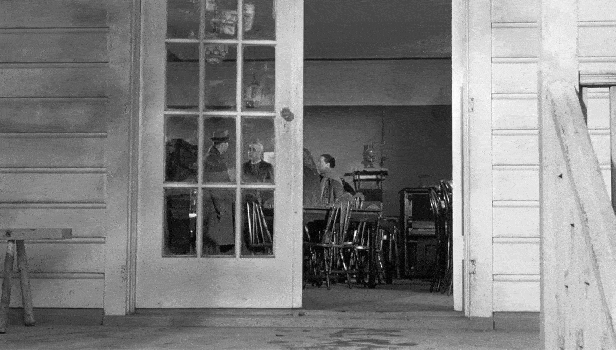
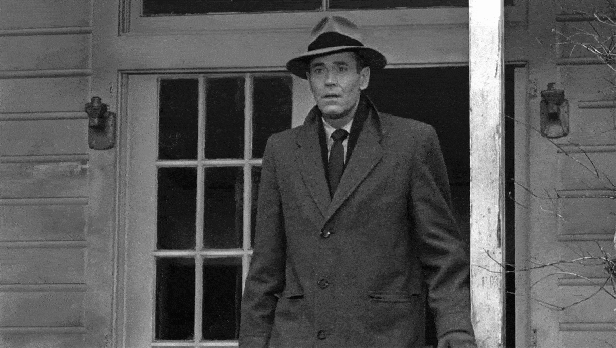
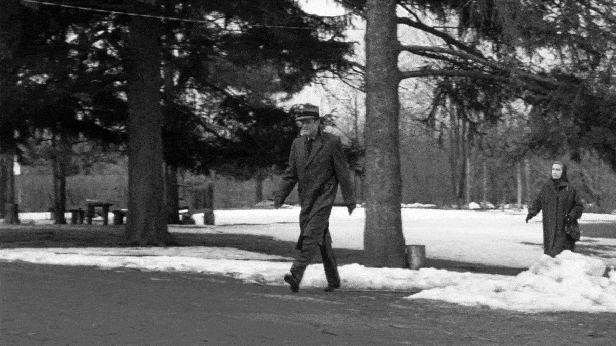
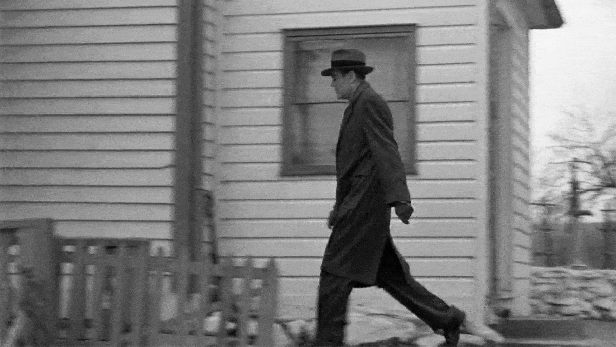
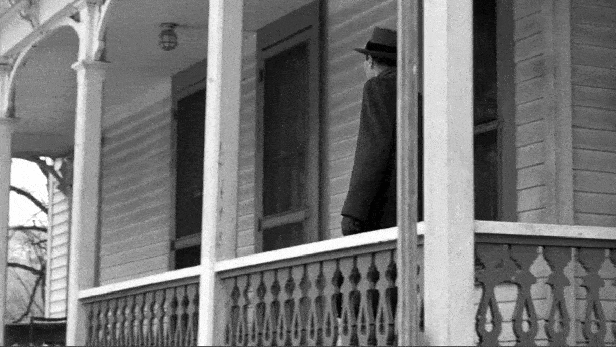

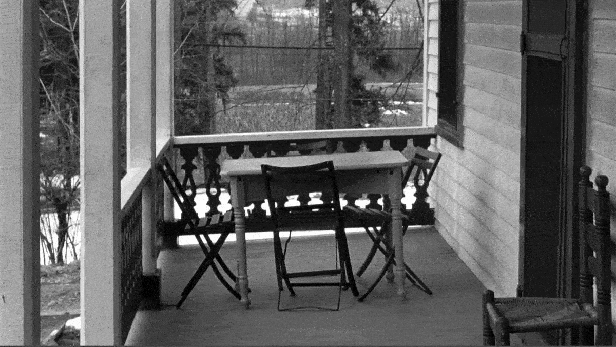
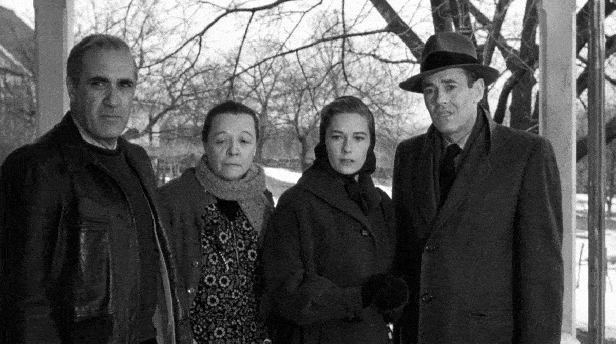
This farm location presented a bit of a daunting task. Whenever a film production shoots a scene outside of New York City, I usually end up being stumped because the locations are usually very rural with hardly any clues to their whereabouts. In these situations, my only hope is to find some production notes online or a detailed book/article that indicates the filming location.
Fortunately, there were a lot of notes and articles out there about The Wrong Man, and the first thing I did was go to the original source material — that 1953 article in Life Magazine— where there’s a reference to an “Edelweiss Farm near Cornwall, N.Y..”
Once I had both a name and a town location, I searched online for any more information abut the farm, hoping I could get an exact address. I ended up finding several articles and book excerpts that mentioned the Cornwall farm, but none of them offered any additional details. (As a side note, while researching Edelweiss Farm, I did stumble across a fun bit of trivia about Cornwall along the way — that Curb Your Enthusiasm co-stars Larry David and Richard Lewis met each other as kids while attending Camp All America in Cornwall-on-Hudson.)
Eventually I found a comment on The Movie-Tourist website by a John F, Cox that offered a little more information. He said that the farm was “a res on the north side of Angola Rd across from the Grover C Cox, Sr res (deceased).” With that new information, I was then able to find was a small announcement in a local paper that gave a general description of the land, confirming it to be on Angola Road. So, if Edelweiss Farm was truly next to the Grover Cox’s land, then it too was on Angola.

It was right around then that it suddenly dawned upon me that I had an untapped source — my friend Bill who actually lived in Cornwall-on-Hudson. I knew he was quite involved in local politics and community affairs. so I figured he could either find the location of the farm or find someone in town who knew the location of the farm.
A couple weeks after I sent Bill the request, he got back to me with an address — 76 Angola Road. He said he asked around and was given an approximate location by a couple folks who told him the property belonged to a local allergist. Knowing roughly where the allergist lived, Bill looked on Google Earth and found what looked like one of the houses from the film. It was hard to see because of some of the tree coverage and the low-resolution, but there was enough there to be able to match up a couple key design elements.
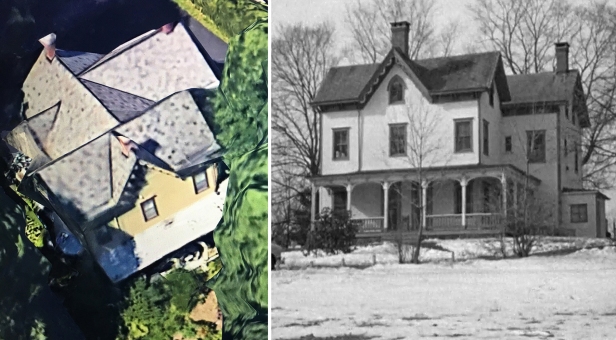
A few days later, Bill drove by the property and snapped a couple quick pictures from his car and sent them to me. The quality of the pics weren’t so great, but they were the last piece of evidence I needed to conclude that we found the right place.
Knowing that at least one of the original houses was still standing, I made a trip up north in July of 2018 to take some more detailed photos of the property (and also help Jeff Blakeslee and his wife move into their new home in nearby Beacon, NY). Once there, I was excited to discover that the other building was still there too, and relatively unchanged.
Whenever I’m taking pictures at a film location, I tend to get caught up with getting the right angles and composition, and don’t always take the time to appreciate where I am. But when I was on the property in Cornwall taking a picture of the doors to the recreation building, I got a sudden chill down my back. Maybe it was because I was in a secluded location without anyone else around or because the recreation building looked practically untouched since The Wrong Man was filmed, but I felt I could almost reach out and touch the spirit of Henry Fonda as he descended the stairs before me. It was one of the few times I got a real thrill being at a film location.
Looking For a Witness
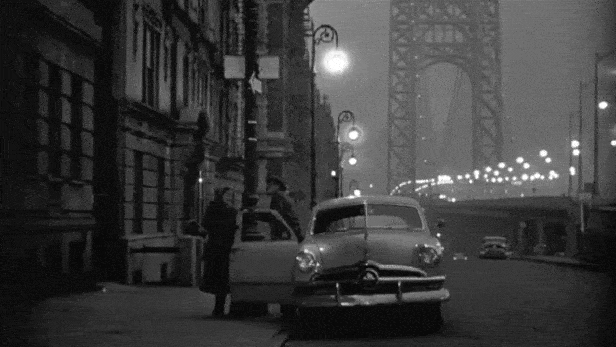
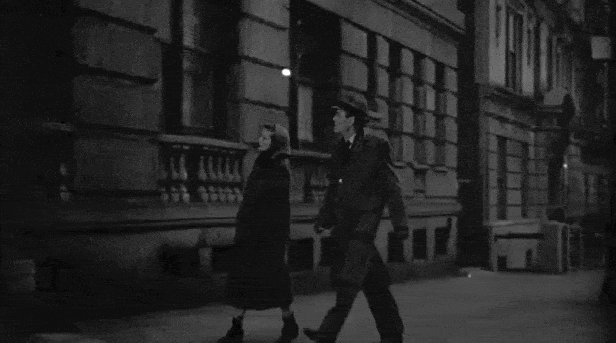
This was one of those super obvious locations that comes along in a movie every once in a while. With the George Washington Bridge looming in the background, it wasn’t too hard to find the exact building used in this scene.
Whenever I encounter one of these scenes with an unmistakable landmark, it obviously doesn’t take much work to figure out the location, however, I must admit that it takes all the fun out of it. There’s something thrilling about discovering a location that, by all accounts, is quintessentially New York, but takes place at some random nook that is completely off the beaten path.
Looking For a Witness on the Waterfront

This was obviously shot in some waterfront area in New York, but the question was — where? The one big clue was the ship in the background. My hope was to figure out the name of the ship, then figure out if it regularly moored at a particular pier.
Unable to read what the name said on the side of the vessel, I enlisted Blakeslee’s help, since he is quite deft at deciphering blurry or incomplete words. After a little studying of a zoomed-in frame from the film, he concluded it was the SS Kathryn (originally a military cargo ship, called the USS Duplin). After a little digging around, we discovered that that ship’s regular port was at the “Brooklyn Piers,” in particular, Pier C, which was in the Gowanus Bay area.
From there, it was off to the New York City Municipal Archives in search of any tax photos from the area. Figuring Fonda and Miles entered a multistory building, it didn’t take too much searching before we focused in on 704 3rd Avenue on the corner of 22nd Street (shown in the above image). Next to that building were a series of stables/garages which clearly matched what was seen in the film, confirming this location.
I have to admit, I was originally a bit surprised that this scene took place in Brooklyn, as I was almost certain it took place somewhere near the South Street Seaport in Manhattan. I came to this conclusion because I thought I saw what looked like either the Brooklyn or Manhattan Bridge in the background between the ship and the building they enter. But it turns out, it was just some generic derricks and whatnot on the pier. (Perspective issues.)
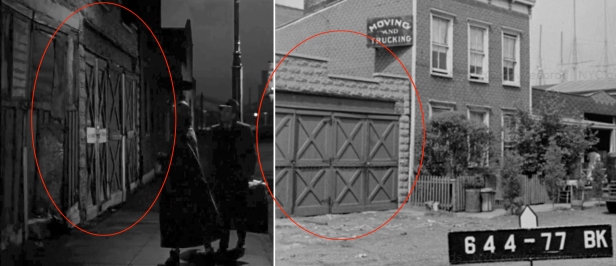
As expected, most of the buildings from the scene are long gone, but the building at 40 22nd Street is still standing. (It’s pretty much the last structure on the block with a pointy top.) Also, as far as I can tell, the large hanger-like buildings on 21st Street (which are partially visible on the right side of the frame at the top of this scene) have also survived.
While not a lot, it’s still more than I anticipated when first started investigating this scene.
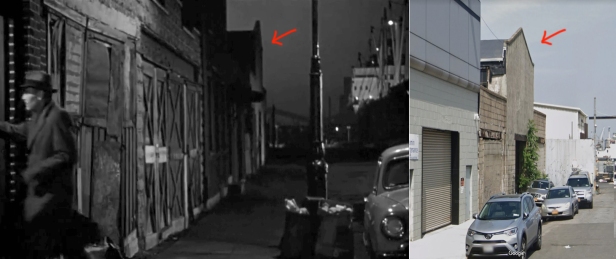
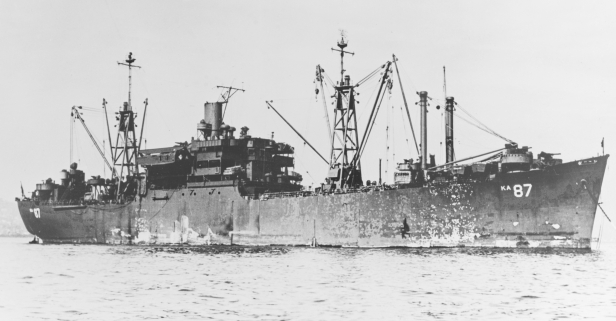
As to the ship, after serving in World War II, it was decommissioned by the Navy in 1946 and sold into merchant service, where its name was changed from USS Duplin to SS Kathryn and it worked out of the piers seen in this film. After being bought and sold several times throughout the 1960s (as well as being renamed at least two more times), the ship was finally scrapped in January of 1971.
Sanitarium

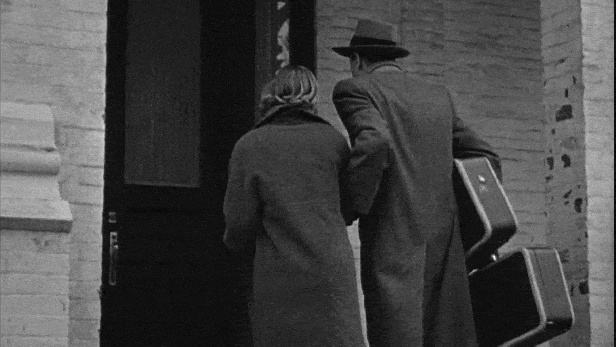
When I began researching the location of this scene, I found many modern sources indicating that Hitchcock filmed at the same hospital the real Rose Balestrero went to — a place called Greenmont Sanitarium in Ossining, NY (since demolished). But knowing that misinformation can sometimes be spread around the web, I wanted to find a contemporaneous source which mentioned the hospital. The only thing I found was a May 10th, 1953 article from The Daily News that said, “Balestrero’s wife suffered a nervous breakdown and was taken to an Ossining sanitarium.” Unfortunately, none of these sources gave an exact address, and when I researched “Greenmont” online, the closest I could come to finding an address was an entry in a 1917 edition of the U.S. and Canada Medical and Surgical Register, which listed the hospital’s location to be on N. Highland Avenue in Ossining.
Homing in on the specific location, I eventually stumbled across an online spreadsheet that listed thousands of North American hospitals, including a “Greenmont-on-Hudson Hospital” at 128 N. Highland Avenue in Ossining. But when I looked on Google Maps, there was a gap in the numbers along Highland and there was no longer a building with an official address of 128.
But by looking at the addresses of neighboring buildings, I figured Greenmont Sanitarium, also known as “Dr. Parsons’ Retreat” (named after its founder), was located near the intersection of N. Highland Avenue and Van Cortland Street. Judging by the lay of the land, I estimated that the “retreat” was probably on the northeast corner of Highland and Van Cortland. However, when I went to the property in person (currently owned by Cablevision), I noticed that there wasn’t any clear view of the houses on the other side of the creek which appeared behind Fonda and Miles in the film. The view was essentially obscured by a medium-sized embankment on the southside of Van Cortland.
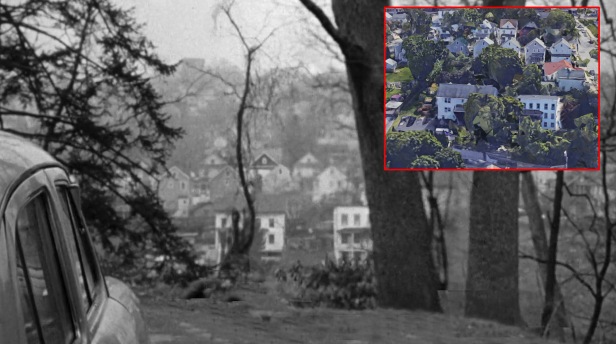
After consulting a 1914 map of Ossining, I realized my estimation of the sanitarium’s location was off just a little bit. On the map, there was a 19-acre parcel of land labeled, “Dr. Ralph L. Parsons” (who I knew was the founding physician of Greenmont) on the southeast corner of Highland and Van Cortland. That would place the hospital on top of that embankment that was blocking my view from before, and thus offer a better vantage of those houses on the other side of the creek.
At this point I was 90 percent sure I found the correct location, but I was still hoping to find a photo of the sanitarium to help seal the deal. I reached out to the Ossining Historical Society, and they were able to provide me with the next best thing. Patty, one of the volunteers at the organization, found a village map from 1862 that amazingly had a small illustration of the building. The map was mounted on the wall and was too big for her to scan, so I decided to visit the museum in person, and sure enough, the map had a nicely detailed illustration and it matched the hospital from the film.
While at the Ossining museum, Patty and the other two volunteers, Joe and George, were extremely friendly and outgoing — telling me stories and searching through old files in hope of finding any more information about the property. Joe, who used to be Chief of Police in Ossining, said he remembered the old hospital building when it was abandoned in the 1970’s. After searching through some records, we estimated that the structure was probably demolished in ’73, as the new apartment buildings on the property today were completed in ’74.
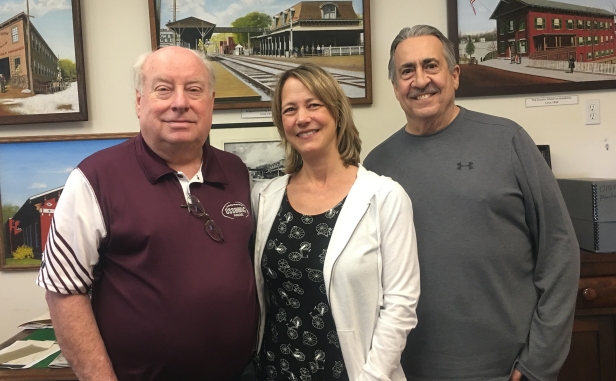
I spent a good hour and a half in the museum and it was a joy to speak with people as interested in movies and history as I am. In exchange for all their kind assistance, I offered to help pick up and transport a large antique victrola from an Ossining resident who was donating it to the Historical Society. It was a bit heavier than I thought it’d be, but a few strained muscles was a tiny price to pay for some small town hospitality.
The Trial
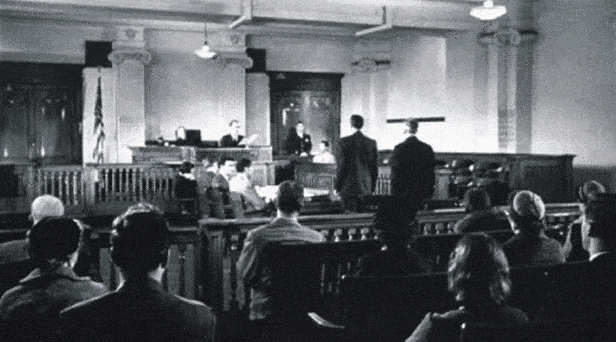
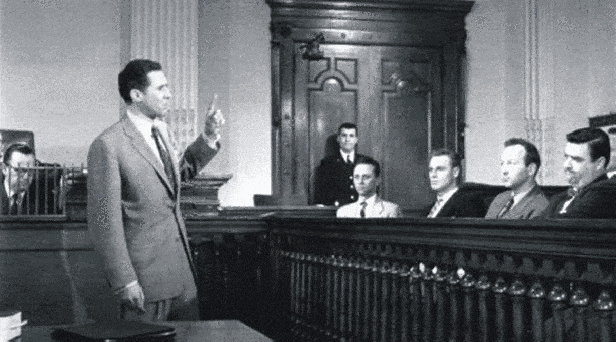
Like the rest of the movie, these interiors were shot on location — inside the actual courthouse in Queens where the real Manny Balestrero was tried. I found these photos of of the courthouse on a Hitchcock fan page, taken by Nándor Bokor during his trip to New York City in 2003. I was amazed to see that the inside of the courtroom had hardly changed in 50 years.
I’m hoping to see if I can get inside myself someday to take some more current pictures, but getting permission may be a little tricky, so I’m glad we have Bokor’s photos as a semi-current visual record.
The Robbery
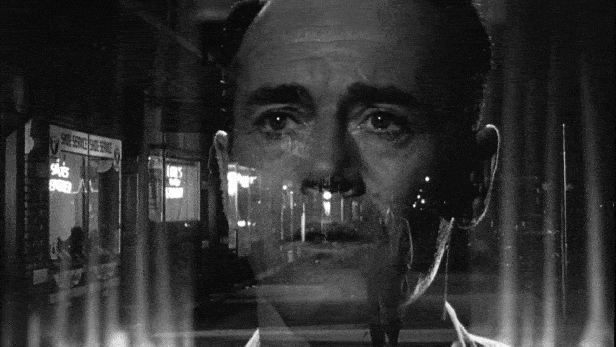
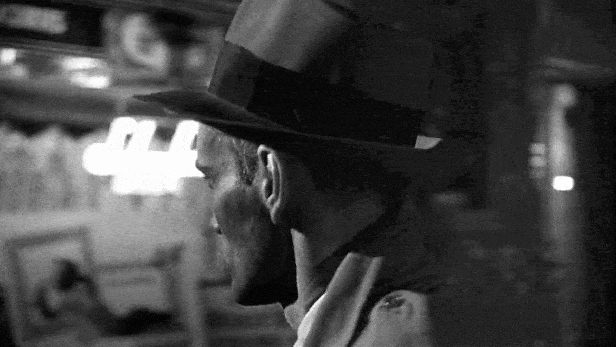

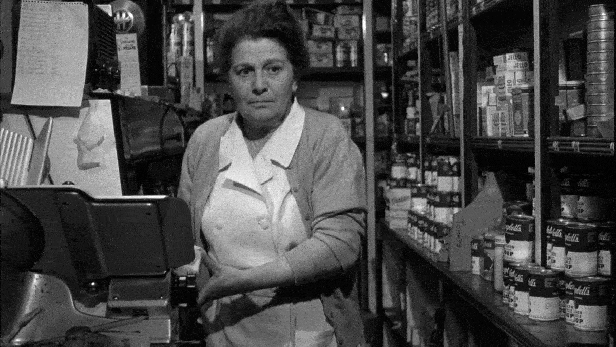
-
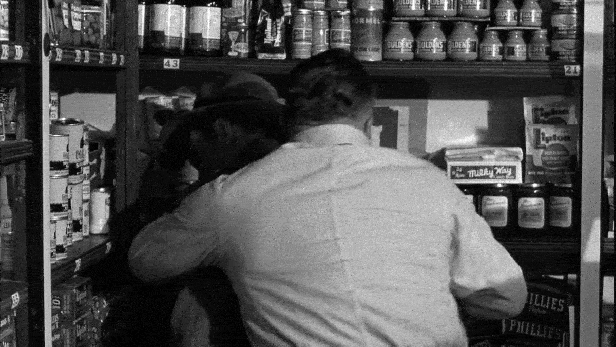
Then, the husband pops up from the basement and is able to subdue the robber.
This was the last location to be found for this film, and it was all Blakeslee’s doing.
Knowing that Hitchcock filmed at many of the actual real life locations, Blakeslee researched the robbery that eventually helped exonerate Balestrero, and eventually found a couple newspaper articles detailing the crime.
From a October 3, 1954 issue of the Daily News:
In Astoria, a heavily populated community to the northwest of Jackson Heights. Joseph Mank was tending his delicatessen at 42-30 34th Ave. His wife, Frieda, 40, was walking the dog outside when she saw a man pacing up and down in front of the store. She warned her husband about the man. “I don’t like his looks,” she said.
“You know our signal,” said Mank. ”I’m going downstairs to the refrigerator. If anything goes wrong, stamp your foot on the floor.”
The loiterer walked in as Mank disappeared into the cellar. He ordered $7 worth of cold cuts, and while Mrs. Mank was cutting the meats, he pulled a gun and demanded cash. She stamped sharply on the floor.
On his cellar phone, Mank called the police. Then he ran upstairs to discover a tall, slender man behind the counter and a courageous Mrs. Mank waving a butcher knife. Menacing her with the gun, the robber was saying, “Don’t come near me. Don’t make me shoot you!”
At that moment the police arrived, guns drawn. Detective William Allmendinger jumped on the holdup man’s back, knocked him to the floor and took his gun away. (It proved to be a toy.) At the station house, the prisoner identified himself as Charles Daniell, an unemployed plastic molder.
And from an earlier May 10, 1953 issue of the newspaper:
Charles Daniell, 38, of 89-04 34th Ave., Astoria, admitted committing the two holdups for which the musician was tried. Daniell, who bears an amazing resemblance to Balestrero, was nabbed April 29, outside an Astoria delicatessen. He readily confessed to some 40 jobs, including the pair of insurance stickups.
Having discovered the address of the deli from the real-life robbery, Blakeslee then looked at the scene to see if there was an indication that the deli in the film was the same one. And amazingly, he was able to spot some letters stenciled on the glass by the front door that read, “MANK” — the same surname mentioned in the Daily News articles.
He and I both agreed that the lettering looked authentic and thought it was highly unlikely that it was set-dressing. Looking in Google Street View, we saw that there was still a deli at that address, but it looked nothing like the one in the film. And because the scene was filmed at night, it was difficult to identify any matching elements from the neighboring buildings, but a small window next to storefront and a pair of residential entrances seemed to look the same.
I then found a 1940’s tax photo of the corner deli, and it looked a lot like the one from the film. Plus the photo showed a few more elements from the neighboring building that matched the film.
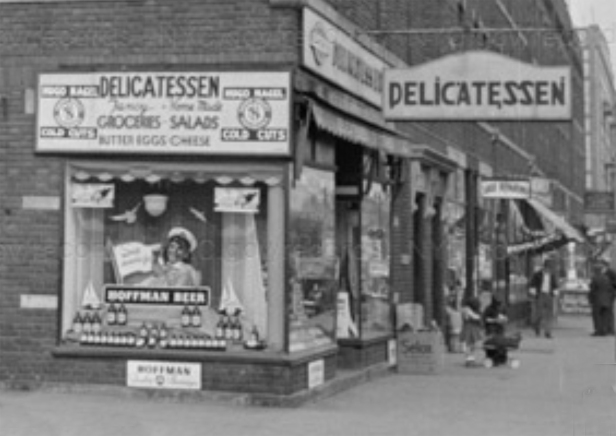
A photo of the corner delicatessen at 42-20 34th Avenue, circa 1942. 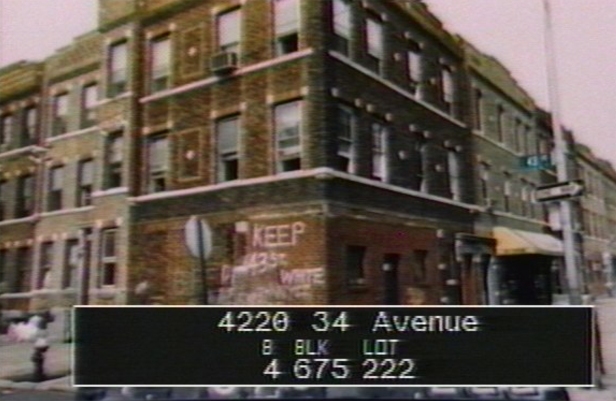
The same corner building during the 1980’s, looking very different. (Note the bigoted graffiti on the wall that reads, “Keep 43 St. white.”) At this point, we were both pretty confident we found the right place, so I went to the location to take some photos. While there, I talked to the deli’s current owner — an amiable Greek fellow named Andy. He told me that before he bought the shop in the late 1990’s, the space used to be a “private club,” where the basic commodities were sex, drugs and alcohol.
He bought the property a few months after the cops shut the club down and did significant renovations to the place, including installing large display windows in the front because, as he told me, “There were no windows here before.”
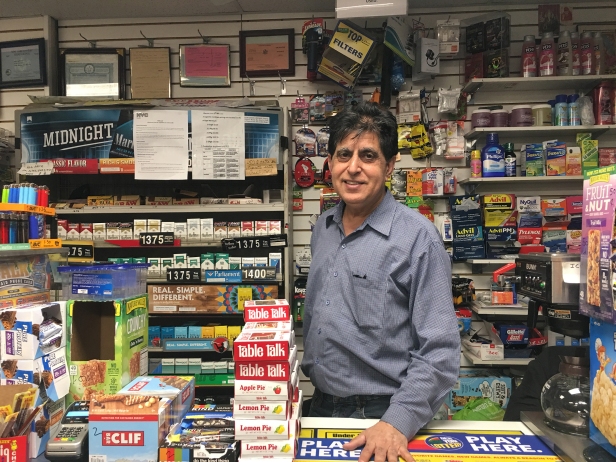
Andy, the current owner of the Astoria delicatessen. When I informed Andy that Alfred Hitchcock shot a scene at his store, his eyes lit up, as if I jogged something loose in his brain. He told me that a couple years ago, his 90-year old neighbor (a life-long Astoria resident) told him that “an old movie” was shot at his place. Even though this was just anecdotal, I was still thrilled to get another piece of evidence that seemed to confirm that Blakeslee and I found the correct delicatessen.

Alfred Hitchcock sits on the lap of a young Irene Mank at her parents’ delicatessen. UPDATE: A few months after publishing this post, I received an unexpected but quite welcome email from an Irene Morganson, who is the daughter of the real-life proprietors of the delicatessen, Josef and Elfriede Mank, and who still owned the shop when it was used for this scene.
Even though she was only 9 years old at the time, it’s clear she still has vivid memories of her family delicatessen today. She shared with me a few details of the Queens store and the time the famous film director (along with his pet dog) were there. She also shared an amazing behind-the-scenes photograph of her and Hitchcock taken during the making of film. Apparently, she was sitting in a corner when he just plopped himself down onto her lap and her father quickly snapped a picture.
My parents were Josef and Elfriede Mank. They owned the delicatessen at 4220 34th Avenue from 1949 to 1966. My mother was in the store and my father was in the basement when they were held-up. Our boxer was in the store also. My mother started stamping her feet when she was threatened. This signaled my father who came up from the cellar and he seized the robber from behind.
When the movie was filmed, the actors used our home a street away (42nd Street) for their make-up and dressing room. I have autographs from the actors. Alfred Hitchcock’s did his famous silhouette as part of his.
While the cast and crew were there for only a short period, it obviously had a lasting memory on a young Irene.
I’m so grateful that she took the time to write in and share a personal photograph of the day Hollywood came to her unassuming Queens neighborhood in the spring of 1956. Getting an email like that was the perfect ending to my research into one of Hitchcock’s most fascinating and anomalous films.

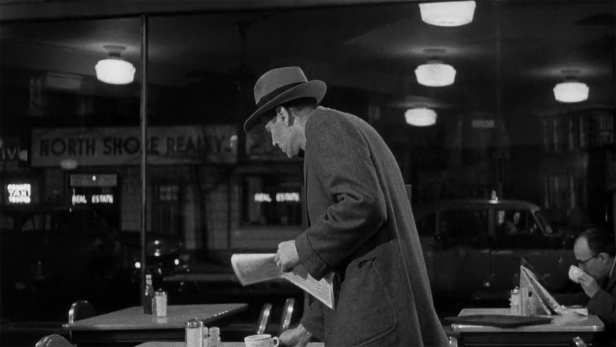
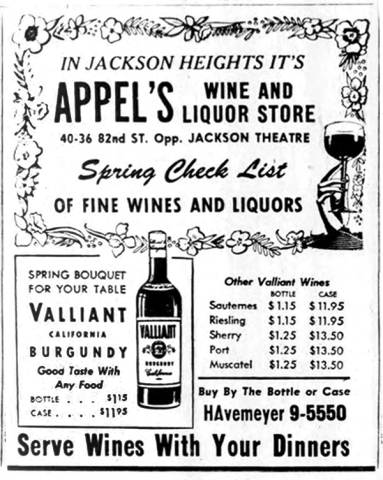
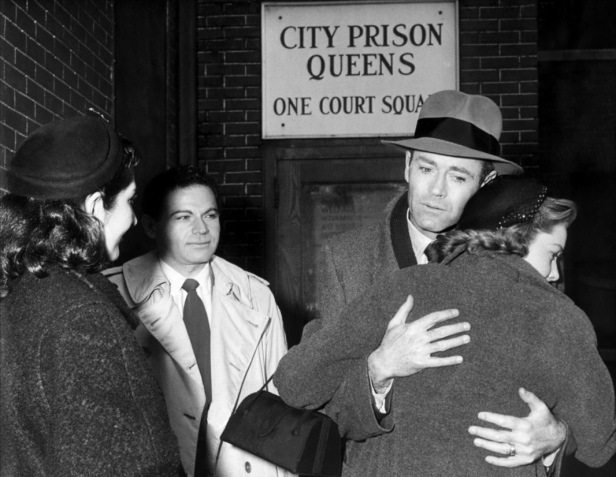




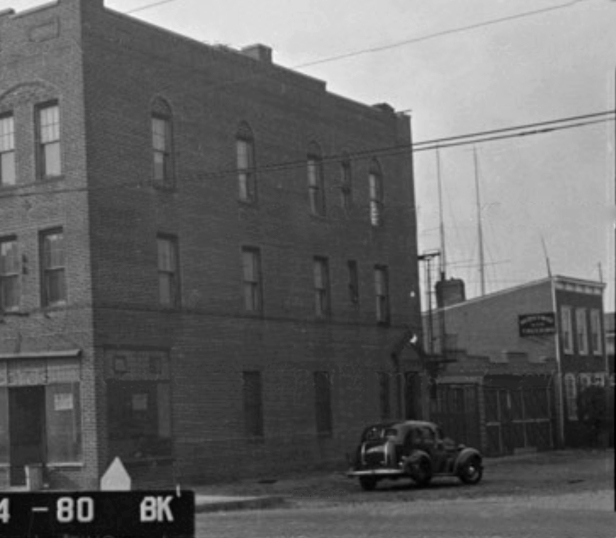
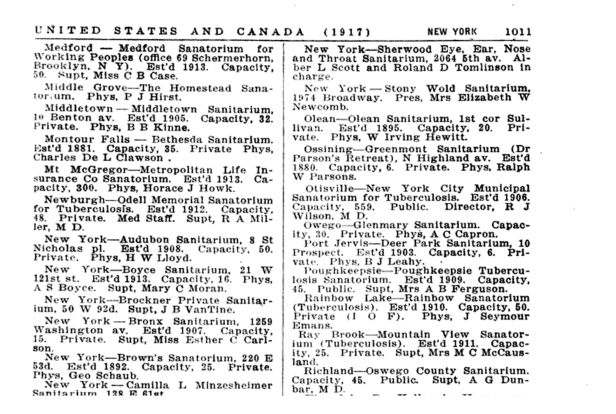
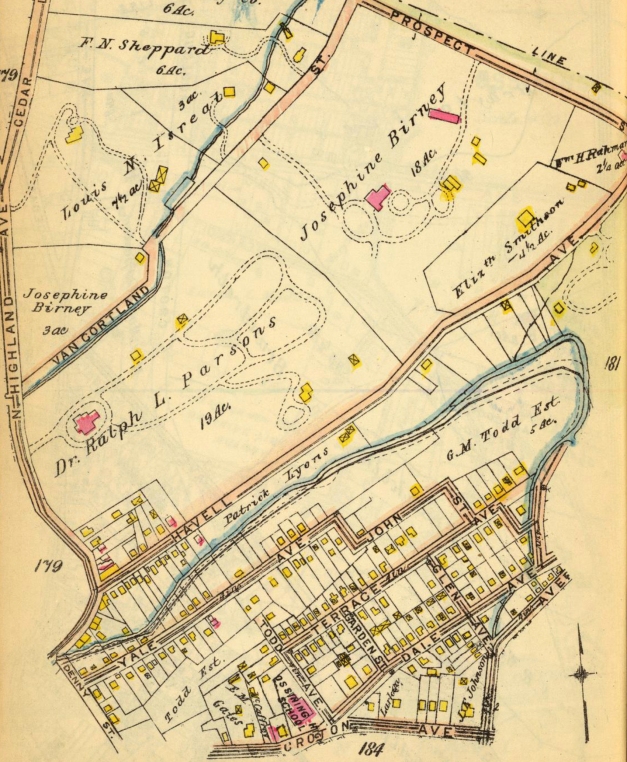

This is an extraordinary site. I cannot thank you enough for it. I love old New York, in black and white, pre 1965. Thanks again for your hard work and love of movies.
LikeLike
You did a wonderful job, Mark! Congratulations, Nandor Bokor from Hungary
LikeLiked by 1 person
This is really cool. Great job. You should do this more often and make a doc about this.
LikeLike
Great job and excellent story! I have lived in Ossining since 1969 and am a member of the Ossining Historical Society. I was made aware of your blog through a story in the latest issue of The Ossining Historian. As Greenmount was being torn down in the early 1970’s my father and I visited the site and took away moldings and other artifacts that were being discarded. We made picture frames out of the moldings and I still have one today. I know the exact location of where the house stood, but have been unable to find a picture until your blog. Brought back great memories. Thanks very much!
LikeLike
Greenmont on Hudson was located at 120 North Highland Avenue in Ossining and was owned and operated by my great Uncle, Dr.Edmund Barnes. Dr, Barnes passed away in 1948 and is interred in Ossining.
LikeLike
You are definitely The Right Man for this fantastic research job. As a Hitch fanatic I can’t thank you enough for your work finding these locations and posting the results. I particularly like your statements about the “search” being the really fun part of the work. Following The Man Who Knew Too Much and preceding Vertigo, The Wrong Man is another of Hitchcock’s mature masterpieces and concrete evidence of his great versatility as a film maker. Again, great job on your part. I’ve bookmarked your page and will refer to it often.
LikeLike
i’ve spent just a few minutes looking at this after having watched The Wrong Man for the first time this evening. “extraordinary” is right! i am really impressed with this wonderful site and can only imagine all the work that went into compiling all the information and photos. this is exactly the kind of thing i would like to see made available for my own and other cities but you may be the only person who has taken on such a task. i think there should be a way of searching virtually any address and finding photos and history regarding the location but i doubt that there are many people with the patience or skill to do what you have done. thank you so much for doing this! btw the last time i was in New York i tried to look for some areas related to The Naked City but never learned for sure whether the yard of old gravestones was the same place one of the characters had run through in the film. maybe someone will do a similar piece on that movie sometime.
LikeLike
Thanks for you comments, Carleton. Finding locations for “The Wrong Man” has been one of the more rewarding experiences since I began this “NYC in Film” project. I have been working on “Naked City” locations as well and will hopefully publish a post for it once I’ve collected all the modern pictures. If you are talking about the Jewish gravestone vendor that appears at the end of the film during the chase, it was at 254 East 1st Street. The street has since merged with East Houston and the yard has been replaced with a large residential/commercial building that covers almost the entire block (250 E Houston).
LikeLike
wow, you are really incredible! i forget what location i guessed the gravestone place was but we found a spot that looked similar to the shot in the movie and i asked the young man there to check with his father or whoever the older worker there was but no one ever got back to me. was that new building constructed within the last 5 or 10 years? i also visited the Gretsch building in Brooklyn but of course the security guard knew nothing about its history as a musical instrument factory. i am also very much interested in any Beat Generation locales (i have the small book about this) and labor, socialist and communist history. thank you so much for what you’re doing and have done!
LikeLike
I was a nine yr.old kid in Ridgewood. We lived on 64th St. and the 104Pct and Ridgewood Court House were right on our corner. My grandma always wanted me to go to the deli on the near corner across from the Court House . She told me what she wanted and off I went. At the corner a big black Cadillac was parked and a woman was in the back seat with the street side door open. Someone was applying make-up. I went into the store which was very narrow. It had shelves up to the ceiling on the right and a cooler with salad and cold cuts on the left. Straight back was an small ice cream box and a soda one too. I was telling the man my grandma order and looked at two men standing at the ice cream box with styrofoam cups of coffee. One was Alfred Hitchcock, who I recognized from his TV show . The other was Henry Fonda in an overcoat and fedora- his costume for the scene. He waited until I got my bag and then bought a pack of smokes (Pall Mal).
He nodded at me and I said nothing. I only told my mother about this that day. It was the film crew and actors shooting the courtroom scenes for Wrong Man. And my father was a beat cop in the 110th Pct on Roosevelt Ave. He knew the story but never said much about it, which was his way of dealing with his job. Long time memories and the first time I saw a ‘filmed on location’ movie and meet a famous actor and director.
LikeLike
I grew up on 74st off Broadway. The cafeteria he’s sitting in was Bickford’s. It was in the spot that you mentioned. One side was on Roosevelt Ave and 74st and the other side was on Broadway. It was part of the tear down, when the new subway station was built.
LikeLiked by 1 person
Thanks for the info, Rob. It’s good to know the proper name.
LikeLike
Mark,
You mentioned that you would like to be able to get into the Long Island City courthouse to take pictures. I can do that for you. Personal message me.
Bob
LikeLike
The Greenmont on Hudson was owned and operated by my great Uncle, Dr. Edmund Barnes. The address is 120 North Highland, Ossining. Dr.Barnes passed away in 1948 and my Great aunt, Jean Barnes passed away in 1945. Son, Homer, a Silver Star winner, was killed in France in September 1944 and all are interred in Ossining. This information should be easily verifiable.
LikeLike
A long time ago in 1979 I had to change from the Q33 Bus from the airport to the train. When I first saw “The Wrong Man” I recognized the arcade immediately.
Thanks for all your work on this.
LikeLike